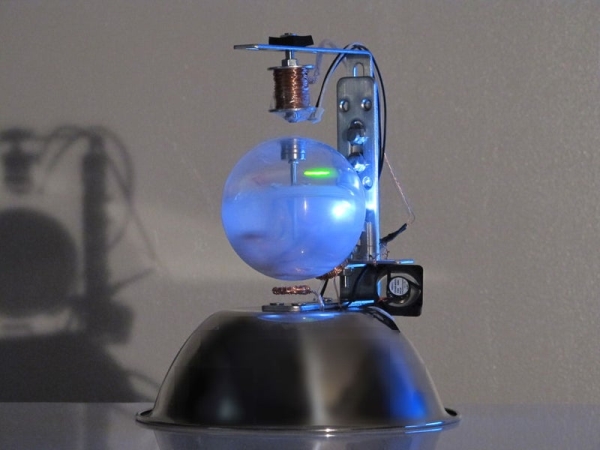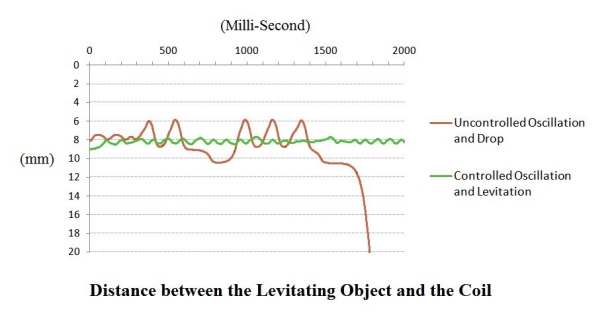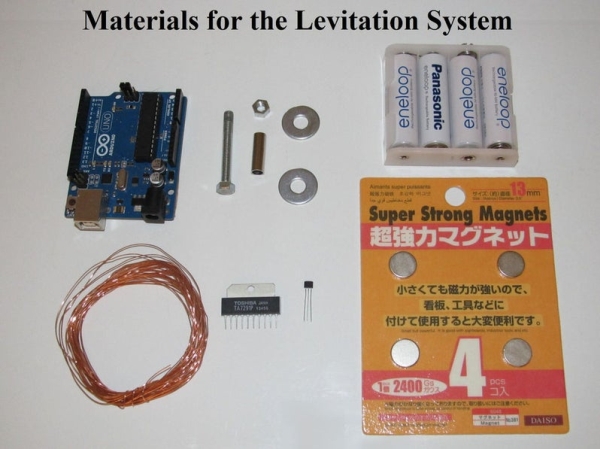
A levitating little Death Star in Instructables invited me to the new project with Arduino. Three policies were decided and kept to differentiate it from the forerunner.
- Do it myself with no (or less) ready-made.
- Keep rotating.
- Make glow and blink without battery.
- VIDEO(1): A Levitating Sphere Rotates Glows and Blinks
The detail of the project is described below. Let’s wrap coils, and make a sphere levitate, rotate, glow and blink! I wish videos and pictures could cover my poor English.
(*) The sphere continues levitating, rotating, glowing and blinking on a dining table for 40 days more. Now it is given a prize in the Make It Move contest 2016. Thank you for your vote.
(**) The MS-Excel simulator used in Step5 will be posted in a few months. Now it is being improved for public use.
(***) The Japanese translation was published in Instrictables also.
Step 1: Get Solution Against the Oscillation

It is not difficult to make an object levitate in the air with a small coil and a few additional materials, when you pick up the coil between your fingers. Arduino with a very simple sketch (program) makes it possible.
On the other hand you will face some obstacles, when the coil is mounted in the rigid frame instead of your fingers. Then the levitating object will begin oscillating and fall to the floor finally. And the levitation is destabilized more rapidly when glowing LED is attached to the levitating object without battery.
To control the oscillation, some vibration damper (absorber) should be added to the system. If the distance between the levitating object and the coil were measured continuously and correctly, a few lines added to the sketch could work well as a virtual damper without any real materials.
But the output value of the magnetic sensor used to measure the distance is polluted by the dynamic magnetic field generated by the coil which controls the levitation. Hence some proper dynamic filtering method is needed in the sketch to estimate the correct distance. On the other hand if Arduino did not have enough power to execute it, some physical damper might be required additionally.
Step 2: Gather Materials

When you pick up the coil between your fingers in the simple levitation system, Arduino with the minimum sketch can make 50g weight levitate in the air easily. The materials of the system are listed under “LEVITATION SYSTEM” below.
Here the hardest work is winding a 20m copper wire around an iron bolt. And the most important stuff is the magnetic sensor called “Hall effect sensor”. Even in the same system, only 5g weight cannot levitate with the sensor which measures narrower range.
LEVITATION SYSTEM
- Arduino UNO
- Iron hexagon head bolt and nut as the core of the coil (5mm Dia. *40mm)
- Iron cylindrical spacer for the bolt above (5mm Dia. *20mm)
- Two large stainless steel flat-washers as the flanges at the ends of the spacer
- Thin copper wire coiled around the spacer (0.4mm Dia. *20m)
- Motor driver IC: Toshiba TA7291P
- Hall effect sensor: Allegro UGN3503UA
- Several neodymium magnets (12mm Dia. *2mm): I got them at a dollar store.
- Power supply unit for the coil (5-6V): 4 AA batteries can work.
To mount the coil in the rigid frame instead of your fingers, and to cover the naked electrical parts, the materials listed under “SUSPENSION STAND” are used. And the components listed under “SPHERE with WIRELESS JOULE THIEF” should be prepared to let LEDs glow and blink without battery. Furthermore, the parts listed under “ROTATION SYSTEM” are needed to make the object rotate continuously in levitation.
SUSPENSION STAND
- Two stainless steel brackets
- Stainless steel bowl (150mm Dia.)
- Several stainless steel bolts and nuts to join the brackets and bowl together
- Low-repulsion urethane sheet or chip (5mm Thick)
- Power supply unit for Arduino (9-12V)
SPHERE with WIRELESS JOULE THIEF
- Clear plastic capsule (70mm Dia.): Gachapon capsule I use.
- Thin copper wire for transmitter and receiver coils (0.4mm Dia. *20m in total)
- LED(s)
- Transistor: Toshiba 2SC1815
- Resistor (1000ohm)
- Capacitor (0.1uF)
- Two small steel cups (40mm Dia.): I got them at a dollar store.
- Power supply unit for the transmitter (5V)
ROTATION SYSTEM
- Small electric fan (working with 5-6V)
- Two small stainless steel brackets to join the fan and the main frame
- Some stainless steel bolts and nuts to join the brackets together
Read more: A Levitating Sphere Rotates Glows and Blinks With Arduino
